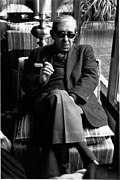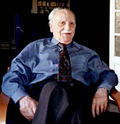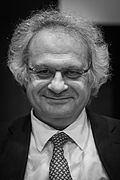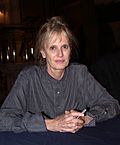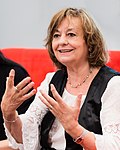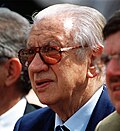Top Qs
Timeline
Chat
Perspective
Princess of Asturias Awards
Annual prizes awarded in Spain From Wikipedia, the free encyclopedia
Remove ads
The Princess of Asturias Awards[1] (Spanish: Premios Princesa de Asturias, Asturian: Premios Princesa d'Asturies), formerly the Prince of Asturias Awards from 1981 to 2014 (Spanish: Premios Príncipe de Asturias), are a series of annual prizes awarded in Spain by the Princess of Asturias Foundation (previously the Prince of Asturias Foundation) to individuals, entities or organizations from around the world who make notable achievements in the sciences, humanities, and public affairs.
Remove ads
The awards are presented every October in a solemn ceremony at Teatro Campoamor in Oviedo, the capital of the Principality of Asturias, and are presented by the Princess of Asturias. Each recipient present at the ceremony receives a diploma, a sculpture expressly created for the awards by Spanish sculptor Joan Miró and a pin with the emblem of the Foundation. There is also a monetary prize of €50,000 for each category; this amount is shared if the category has more than one recipient.
They were declared of "exceptional contribution to the cultural heritage of Humanity" by UNESCO in 2004.[2]
Remove ads
Background
Summarize
Perspective

The Prince of Asturias Awards were established on 24 September 1980, with the creation of the Prince of Asturias Foundation, in a ceremony presided by Felipe, Prince of Asturias, then heir to the throne of Spain, "to consolidate links between the Principality and the Prince of Asturias, and to contribute to, encourage and promote scientific, cultural and humanistic values that form part of mankind's universal heritage".[3]
Following the accession of the Prince as King of Spain on 19 June 2014, it was announced that from 2015, the foundation and the awards are to be renamed the Princess of Asturias Awards to reflect the new heiress presumptive to the Spanish throne, Leonor, Princess of Asturias.[4] King Felipe continued to preside over the awards ceremony until the Princess of Asturias turned 18 (the age of majority for Spanish royal purposes) on 31 October 2023. Princess Leonor first attended the ceremony, handed out awards to winners and delivered her first speech ever as heiress to the crown during the 39th Princess of Asturias Awards Ceremony on 18 October 2019. Her father, then Prince Felipe, did the same during the 1st Prince of Asturias Awards Ceremony on 31 October 1981.[5]
If a laureate does not attend to the ceremony to collect their award, they receive neither the sculpture nor the monetary prize, even if the absence is because of force majeure. Only a few laureates have not attended; among them are Bob Dylan, who refused to go to Oviedo in 2007 but asked for the sculpture unsuccessfully, writer Philip Roth in 2012 for medical reasons, and Pau and Marc Gasol in 2015, who were not allowed to attend by their NBA teams.[6]
Remove ads
Categories and laureates
Summarize
Perspective
Prince or Princess of Asturias Award for the Arts
First awarded in 1981 it is aimed at recognizing the work of fostering and advancing the art of film-making, theatre, dance, music, photography, painting, sculpture, architecture or any other form of artistic expression.

- 1981: Jesús López Cobos
- 1982: Pablo Serrano
- 1983: Eusebio Sempere
- 1984: Orfeón Donostiarra
- 1985: Antonio López García
- 1986: Luis García Berlanga
- 1987: Eduardo Chillida
- 1988: Jorge Oteiza
- 1989: Oscar Niemeyer
- 1990: Antoni Tàpies
- 1991: Victoria de los Ángeles, Teresa Berganza, Montserrat Caballé, José Carreras, Pilar Lorengar, Alfredo Kraus, and Plácido Domingo
- 1992: Roberto Matta
- 1993: Francisco Javier Sáenz de Oiza
- 1994: Alicia de Larrocha
- 1995: Fernando Fernán Gómez
- 1996: Joaquín Rodrigo
- 1997: Vittorio Gassman
- 1998: Sebastião Salgado
- 1999: Santiago Calatrava
- 2000: Barbara Hendricks
- 2001: Krzysztof Penderecki
- 2002: Woody Allen
- 2003: Miquel Barceló
- 2004: Paco de Lucía
- 2005: Maya Plisetskaya and Tamara Rojo
- 2006: Pedro Almodóvar
- 2007: Bob Dylan[A]
- 2008: National Network of Youth and Children Orchestras of Venezuela
- 2009: Norman Foster
- 2010: Richard Serra
- 2011: Riccardo Muti
- 2012: Rafael Moneo
- 2013: Michael Haneke
- 2014: Frank Gehry
- 2015: Francis Ford Coppola
- 2016: Núria Espert
- 2017: William Kentridge
- 2018: Martin Scorsese
- 2019: Peter Brook
- 2020: Ennio Morricone[B] and John Williams[C]
- 2021: Marina Abramović
- 2022: Carmen Linares and María Pagés
- 2023: Meryl Streep
- 2024: Joan Manuel Serrat
Prince or Princess of Asturias Award for Communication and Humanities
First awarded in 1981 it is aimed at recognizing the work of fostering and advancing the sciences and disciplines considered humanistic activities or any activity related to social communication in any of its forms.

- 1981: María Zambrano
- 1982: Mario Bunge
- 1983: El País newspaper
- 1984: Claudio Sánchez-Albornoz
- 1985: José Ferrater Mora
- 1986: Grupo Globo
- 1987: El Espectador and El Tiempo newspapers
- 1988: Horacio Sáenz Guerrero
- 1989: Pedro Laín Entralgo and Fondo de Cultura Económica
- 1990: José Simeón Cañas Central American University
- 1991: Luis María Anson
- 1992: Emilio García Gómez
- 1993: Vuelta magazine by Octavio Paz
- 1994: Spanish Missions in Rwanda and Burundi
- 1995: EFE Agency and José Luis López Aranguren
- 1996: Indro Montanelli and Julián Marías
- 1997: Václav Havel and CNN
- 1998: Reinhard Mohn
- 1999: Caro and Cuervo Institute
- 2000: Umberto Eco
- 2001: George Steiner
- 2002: Hans Magnus Enzensberger
- 2003: Ryszard Kapuściński and Gustavo Gutiérrez Merino
- 2004: Jean Daniel
- 2005: Alliance Française, Società Dante Alighieri, British Council, Goethe-Institut, Instituto Cervantes and Instituto Camões
- 2006: National Geographic Society
- 2007: Nature and Science journals
- 2008: Google
- 2009: National Autonomous University of Mexico
- 2010: Alain Touraine and Zygmunt Bauman
- 2011: Royal Society
- 2012: Shigeru Miyamoto
- 2013: Annie Leibovitz
- 2014: Quino
- 2015: Emilio Lledó Íñigo
- 2016: James Nachtwey
- 2017: Les Luthiers
- 2018: Alma Guillermoprieto
- 2019: Museo del Prado
- 2020: Guadalajara International Book Fair[C] and Hay Festival of Literature & Arts
- 2021: Gloria Steinem
- 2022: Adam Michnik
- 2023: Nuccio Ordine[D]
- 2024: Marjane Satrapi[11]
Prince or Princess of Asturias Award for International Cooperation

First awarded in 1981 it is aimed at recognizing individual or collective work, in cooperation with another or others, to develop and promote public health, universal education, the protection and defence of the environment, as well as the economic, cultural and social advancement of peoples.
- 1981: José López Portillo
- 1982: Enrique V. Iglesias
- 1983: Belisario Betancur
- 1984: Contadora group
- 1985: Raúl Alfonsín
- 1986: University of Salamanca and University of Coimbra
- 1987: Javier Pérez de Cuéllar
- 1988: Óscar Arias
- 1989: Jacques Delors and Mikhail Gorbachev
- 1990: Hans-Dietrich Genscher
- 1991: UNHCR (United Nations High Commissioner for Refugees)
- 1992: Frederik W. de Klerk and Nelson Mandela
- 1993: United Nations Blue Berets stationed in Ex-Yugoslavia
- 1994: Yitzhak Rabin and Yasser Arafat
- 1995: Mário Soares
- 1996: Helmut Kohl
- 1997: Government of Guatemala and Guatemalan National Revolutionary Unity
- 1998: Emma Bonino, Olayinka Koso-Thomas, Graça Machel, Fatiha Boudiaf, Rigoberta Menchú, Fatana Ishaq Gailani and Somaly Mam
- 1999: Pedro Duque, John Glenn, Chiaki Mukai and Valeri Polyakov
- 2000: Fernando Henrique Cardoso
- 2001: International Space Station
- 2002: The Scientific Committee on Antarctic Research
- 2003: Luiz Inácio Lula da Silva
- 2004: The European Union's Erasmus Programme
- 2005: Simone Veil
- 2006: Bill & Melinda Gates Foundation
- 2007: Al Gore
- 2008: Manhiça Centre of Health Research (Mozambique), Ifakara Health Institute (Tanzania), Malaria Research and Training Centre (Mali) and Kintampo Health Research Centre (Ghana)
- 2009: World Health Organization
- 2010: The Transplantation Society and the Spanish National Transplant Organization
- 2011: Bill Drayton
- 2012: International Red Cross and Red Crescent Movement
- 2013: Max Planck Society for the Advancement of Science
- 2014: Fulbright Program
- 2015: Wikipedia
- 2016: United Nations Framework Convention on Climate Change and the Paris Agreement
- 2017: The Hispanic Society of America
- 2018: Amref Health Africa
- 2019: Salman Khan and the Khan Academy
- 2020: Gavi, the Vaccine Alliance[C]
- 2021: CAMFED, Campaign for Female Education
- 2022: Ellen MacArthur
- 2023: Drugs for Neglected Diseases initiative
- 2024: Organization of Ibero-American States for Education, Science and Culture (OEI)
Prince or Princess of Asturias Award for Literature
First awarded in 1981 it is aimed at recognizing the work of fostering and advancing literary creation in all its genres.
Prince or Princess of Asturias Award for Social Sciences
First awarded in 1981 it is aimed at recognizing creative and/or research work in the field of history, law, linguistics, teaching, political science, psychology, sociology, ethics, philosophy, geography, economics, demography or anthropology, as well as in the disciplines corresponding to each of these fields.

- 1981: Román Perpiñá Grau
- 1982: Antonio Domínguez Ortiz
- 1983: Julio Caro Baroja
- 1984: Eduardo García de Enterría
- 1985: Ramón Carande Thovar
- 1986: José Luis Pinillos Díaz
- 1987: Juan José Linz
- 1988: Luis Díez del Corral and Luis Sánchez Agesta
- 1989: Enrique Fuentes Quintana
- 1990: Rodrigo Uría González
- 1991: Miguel Artola Gallego
- 1992: Juan Velarde Fuertes
- 1993: Silvio Zavala
- 1994: Aurelio Menéndez Menéndez
- 1995: Joaquim Veríssimo Serrão and Miquel Batllori
- 1996: John H. Elliott
- 1997: Martí de Riquer i Morera
- 1998: Pierre Werner and Jacques Santer
- 1999: Raymond Carr
- 2000: Carlo Maria Martini
- 2001: El Colegio de México and Juan Iglesias Santos
- 2002: Anthony Giddens
- 2003: Jürgen Habermas
- 2004: Paul Krugman
- 2005: Giovanni Sartori
- 2006: Mary Robinson
- 2007: Ralf Dahrendorf
- 2008: Tzvetan Todorov
- 2009: David Attenborough
- 2010: The archaeological team of the Terra Cotta Warriors and Horses of Xi'an
- 2011: Howard Gardner
- 2012: Martha Nussbaum
- 2013: Saskia Sassen
- 2014: Joseph Pérez
- 2015: Esther Duflo
- 2016: Mary Beard
- 2017: Karen Armstrong
- 2018: Michael J. Sandel
- 2019: Alejandro Portes
- 2020: Dani Rodrik[C]
- 2021: Amartya Sen
- 2022: Eduardo Matos Moctezuma
- 2023: Hélène Carrère d'Encausse[F]
- 2024: Michael Ignatieff
Prince or Princess of Asturias Award for Sports
First awarded in 1987 it is aimed at recognizing careers which, via the promotion, fostering and advancement of sport and sense of solidarity and commitment, have become an example of the benefits that practising sports can bring to people.
Prince or Princess of Asturias Award for Technical and Scientific Research
First awarded in 1981 it is aimed at recognizing the work of fostering and advancing research in the field of mathematics, astronomy and astrophysics, physics, chemistry, life sciences, medical sciences, earth and space sciences or technological sciences, including those disciplines corresponding to each of these fields as well as their related technologies.
- 1981: Alberto Sols
- 1982: Manuel Ballester
- 1983: Luis Antonio Santaló Sors
- 1984: Antonio Garcia-Bellido
- 1985: David Vázquez Martínez and Emilio Rosenblueth
- 1986: Antonio González González
- 1987: Jacinto Convit and Pablo Rudomín
- 1988: Manuel Cardona and Marcos Moshinsky
- 1989: Guido Münch
- 1990: Santiago Grisolía and Salvador Moncada
- 1991: Francisco Bolívar Zapata
- 1992: Federico García Moliner
- 1993: Amable Liñán
- 1994: Manuel Patarroyo
- 1995: Manuel Losada Villasante and Instituto Nacional de Biodiversidad of Costa Rica
- 1996: Valentín Fuster
- 1997: Atapuerca research team
- 1998: Emilio Méndez Pérez and Pedro Miguel Echenique Landiríbar
- 1999: Ricardo Miledi and Enrique Moreno González
- 2000: Robert Gallo and Luc Montagnier
- 2001: Craig Venter, John Sulston, Francis Collins, Hamilton Smith and Jean Weissenbach
- 2002: Lawrence Roberts, Robert E. Kahn, Vinton Cerf and Tim Berners-Lee
- 2003: Jane Goodall
- 2004: Judah Folkman, Tony Hunter, Joan Massagué, Bert Vogelstein and Robert Weinberg
- 2005: Antonio Damasio
- 2006: Juan Ignacio Cirac
- 2007: Peter Lawrence and Ginés Morata
- 2008: Sumio Iijima, Shuji Nakamura, Robert Langer, George M. Whitesides and Tobin Marks
- 2009: Martin Cooper and Raymond Tomlinson
- 2010: David Julius, Baruch Minke and Linda R. Watkins
- 2011: Joseph Altman, Arturo Álvarez-Buylla and Giacomo Rizzolatti
- 2012: Gregory Winter and Richard A. Lerner
- 2013: Peter Higgs, François Englert and European Organization for Nuclear Research CERN
- 2014: Avelino Corma Canós, Mark E. Davis and Galen D. Stucky
- 2015: Emmanuelle Charpentier and Jennifer Doudna
- 2016: Hugh Herr
- 2017: Rainer Weiss, Kip S. Thorne, Barry C. Barish and the LIGO Scientific Collaboration
- 2018: Svante Pääbo
- 2019: Joanne Chory and Sandra Myrna Díaz
- 2020: Yves Meyer[C], Ingrid Daubechies[C], Terence Tao[C] and Emmanuel Candès
- 2021: Katalin Karikó, Drew Weissman, Philip Felgner, Uğur Şahin, Özlem Türeci, Derrick Rossi and Sarah Gilbert
- 2022: Geoffrey Hinton, Yann LeCun, Yoshua Bengio and Demis Hassabis
- 2023: Jeffrey I. Gordon, E. Peter Greenberg and Bonnie L. Bassler
- 2024: Daniel J. Drucker, Jeffrey M. Friedman, Joel F. Habener, Jens Juul Holst and Svetlana Mojsov
Prince or Princess of Asturias Award for Concord
First awarded in 1986 it is aimed at recognizing the work of defending and advancing human rights, as well as promoting and protecting peace, freedom, solidarity, world heritage and, in general, the progress of humanity.

- 1986: Vicariate of Solidarity
- 1987: Villa El Salvador
- 1988: International Union for Conservation of Nature and Natural Resources and World Wide Fund for Nature
- 1989: Stephen Hawking
- 1990: Sephardic Communities
- 1991: Médecins Sans Frontières and Medicus Mundi
- 1992: American Foundation for AIDS Research (AMFAR)
- 1993: Association for Peace in the Basque Country
- 1994: National Movement of Street Children, Messengers of Peace and Save the Children
- 1995: H.M. Hussein I, king of Jordan
- 1996: Adolfo Suárez
- 1997: Mstislav Rostropovich and Yehudi Menuhin
- 1998: Nicolás Castellanos, Vicente Ferrer, Joaquín Sanz Gadea and Muhammad Yunus
- 1999: Caritas Spain
- 2000: Royal Spanish Academy and Association of Academies of the Spanish Language
- 2001: World Network of Biosphere Reserves
- 2002: Daniel Barenboim and Edward Said
- 2003: J. K. Rowling
- 2004: The Way of St. James
- 2005: Daughters of Charity of Saint Vincent de Paul
- 2006: UNICEF
- 2007: Yad Vashem
- 2008: Íngrid Betancourt
- 2009: The City of Berlin
- 2010: Manos Unidas
- 2011: Fukushima 50
- 2012: Spanish Federation of Food Banks
- 2013: Spanish Organization for the Blind (ONCE)
- 2014: Caddy Adzuba
- 2015: Hospitaller Order of St John of God
- 2016: SOS Children's Villages
- 2017: European Union
- 2018: Sylvia A. Earle
- 2019: The City of Gdańsk
- 2020: Spanish health workers on the front line against COVID-19
- 2021: José Andrés and the World Central Kitchen
- 2022: Shigeru Ban
- 2023: Mary's Meals
- 2024: Magnum Photos
Exemplary Town of Asturias
Every year, a town or community organization in the Principality of Asturias is chosen to receive this award, a royal visit, and a prize of €25,000.[94]
- 1990: San Esteban de Cuñaba (Peñamellera Baja)
- 1991: Cubera, Asociación de Amigos del Paisaje de Villaviciosa
- 1992: Soto de Luiña and Novellana (Cudillero)
- 1993: Neighborhood Community of Grandas de Salime
- 1994: Shepherds in Picos de Europa (Amieva, Cabrales, Cangas de Onís, and Onís)
- 1995: Puerto de Vega (Navia)
- 1996: Neighborhood Community of Nava
- 1997: Castropol
- 1998: Xomezana and Valle del Huerna (Lena)
- 1999: Neighborhood and Educational Community of Ibias
- 2000: Tuña (Tineo)
- 2001: Paredes (Valdés)
- 2002: Hermandad de La Probe y Comunidad de La Foz de Morcín (Morcín)
- 2003: Navelgas (Tineo)
- 2004: Villar de Vildas (Somiedo)
- 2005: Porrúa (Llanes)
- 2006: Neighborhood Community of Sariego
- 2007: Sociedad Humanitarios de San Martín y Pueblo de Moreda (Aller)
- 2008: Torazo (Cabranes)
- 2009: Neighborhood Community of Sobrescobio
- 2010: Lastres (Colunga)
- 2011: San Tirso de Abres
- 2012: Bueño/Güeñu (Ribera de Arriba)
- 2013: Neighborhood Community of Teverga
- 2014: Associative and neighborhood movement of Boal
- 2015: Colombres (Ribadedeva)
- 2016: Neighborhood Community of Oscos (Santa Eulalia de Oscos, San Martín de Oscos, and Villanueva de Oscos)
- 2017: Poreño (Villaviciosa)
- 2018: Moal (Cangas del Narcea)
- 2019: Asiego (Cabrales)
- 2020: Somao (Pravia)
- 2021: Santa María del Puerto (Somiedo)
- 2022: Cadavéu (Valdés)
- 2023: Arroes, Pion, and Candanal (Villaviciosa)
- 2024: Sotres (Cabrales)
Remove ads
See also
- List of general science and technology awards
- Graciano García García, co-founder of the Prince of Asturias Foundation.
Notes
- Morricone died before the awards ceremony took place. His son Andrea Morricone collected the award at the ceremony on his behalf.[7]
- Due to the COVID-19 pandemic restrictions, the Foundation exempted the laureates from attending the ceremony. The laureate decided not to travel to Oviedo, and even so he/she received the sculpture, pin, diploma and economic endowment.[8][9]
- Ordine died before the awards ceremony took place. His partner and his sister, Rosalia Broccolo and Maria Ordine, collected the award at the ceremony on his behalf.[10]
- The citation for each award is quoted (not in full) from the minutes of the jury in fpa.es, the official website of the Princess of Asturias Foundation. For a full account of the work done by each Prince or Princess of Asturias laureate, please see the biography articles linked from the name column.
- Carrère d'Encausse died before the awards ceremony took place. Her son Emmanuel Carrère collected the award at the ceremony on her behalf.[10]
Remove ads
References
External links
Wikiwand - on
Seamless Wikipedia browsing. On steroids.
Remove ads



